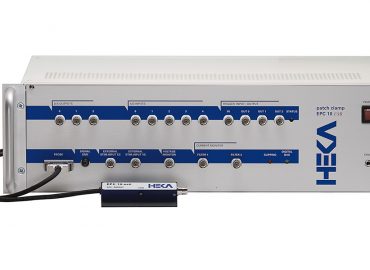Late in 2021 we announced our acquisition of the Hum Bug 50/60Hz Noise Eliminator from Quest Scientific and we have continued to supply Quest-manufactured units, while working on an updated and re-designed version. We are delighted to announce that in recent weeks, the first Digitimer Hum Bugs started shipping to our customers, allowing a seamless transition to the new device. Externally, the new Hum Bug is almost identical to the original, but it is on the inside where the vast majority of changes have been made.
The updated Hum Bug incorporates a newly designed PCB which uses surface mount (SMT) components. Moving away from older “through-hole” components, which are becoming harder to source, will ensure Digitimer can continue to manufacture the Hum Bug for many years to come. The new design also includes a simple voltage selector switch that allows a Hum Bug to be used with 110V or 220V mains supplies with no internal modifications. This will be particularly useful if a user wishes to relocate to different regions of the world or use the Hum Bug as part of a mobile recording set-up.
The Hum Bug Noise Eliminator is the ideal piece of biological research technology, aiding in the removal of mains or line noise (50/60Hz) in signal readings from biological sensors and high impedance devices, without the signal degradation associated with notch filters.
The Problem
- Signals recorded using biological sensors and other high impedance devices are often contaminated with 50 or 60 Hz noise corrupting the content of these signals and degrading the quality of subsequent data analysis.
- Electrical interference is notoriously difficult to remove without altering the original signal embedded within the noise.
- In theory, proper attention to ground and appropriate shielding can eliminate electrical interference. In practice, noise remains a frequent and distressing problem in many laboratories.
- Noise may come and go for no apparent reason and may appear during critical phases of data collection. The effort required to maintain noise at an acceptable level is both time consuming and frustrating.
The Traditional Approach
- Faraday cages decrease the magnitude of environmental noise sources, but this protection is often incomplete.
- Notch or comb mains noise eliminator filters are occasionally used to suppress 50/60 Hz noise and harmonics but a line noise filter will distort the input waveform if the frequency components of the signal overlap with the filtered frequencies.
A New Solution – 50 or 60Hz Noise Removal without Filtering
- Developed by Quest Scientific and now redesigned, manufactured and supplied by Digitimer, the HumBug uses a powerful new technique – 50Hz noise eliminator or 60 Hz noise removal from analogue signals without filtering.
- The Hum Bug noise eliminator constructs a noise replica in real time and continuously subtracts this replica from the input signal. It performs this function in the presence of biological activity even when noise characteristics evolve over time.
- Even if the biological signal has 50Hz or 60Hz components, these will be untouched by the Hum Bug Noise Eliminator.
Simplicity
- The Hum Bug Noise Eliminator is a real-time device. Simply connect it between your preamplifier and any analysis or recording equipment (oscilloscope etc.).
- It will automatically eliminate electrical interference while it lets the signal of interest pass through unchanged. No settings or adjustments are required.
- The front panel switches are only used if you wish to bypass noise cancellation (BYPASS), stop the adaptation process (HOLD), or clear the noise replica (CLEAR).
Need to remove noise from more than one channel?
Those of you wanting to remove mains interference from multiple channels can use more than one Hum Bug, but they are not inexpensive devices. Fortunately, Digitimer have developed our new D400 Two, Four & Eight Channel Main Noise Eliminators for cost-effective mains noise removal in multi-channel recording applications. The D400-2, D400-4 and D400-8 remove mains noise from signals using a similar approach to the Hum Bug, but do so independently for several channels, even making it possible to share a single D400 across multiple rigs.
Want to find out more, please visit the Hum Bug product page or contact us.






